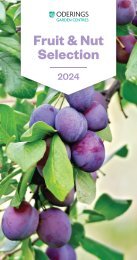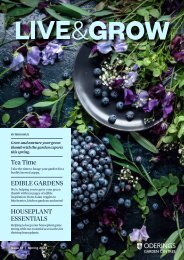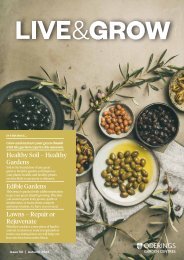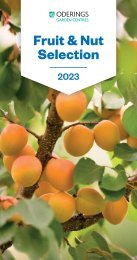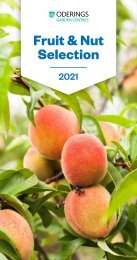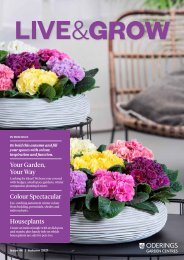You also want an ePaper? Increase the reach of your titles
YUMPU automatically turns print PDFs into web optimized ePapers that Google loves.
IN THIS ISSUE<br />
Packed full of tips and tricks,<br />
this issue is all about<br />
nourishment for your garden<br />
and your houseplants.<br />
What’s New<br />
So much to see with new houseplants,<br />
flowering plants, bird feeders and more.<br />
At Home<br />
Use pressed flower art to bring the<br />
outdoors in.<br />
Herb Drying<br />
Make the most of your herbs by drying<br />
your surplus.<br />
Issue <strong>44</strong> | Autumn 2020
Autumn 2020<br />
What’s Inside<br />
4<br />
<strong>Oderings</strong>-Grown Bedding<br />
New season’s plants from the<br />
<strong>Oderings</strong> Wholesale team.<br />
5<br />
6<br />
8<br />
9<br />
10<br />
Autumn Lawn Care<br />
Kiwicare explain why and how<br />
autumn is the perfect time to get<br />
your lawn healthy in preparation<br />
for winter.<br />
Trending Houseplants<br />
Create a tropical jungle this winter<br />
with colourful foliage.<br />
<strong>Oderings</strong>-Grown Vincas<br />
A selection of extremely popular<br />
ground covers that are so hardy<br />
you can mow them.<br />
The Ocean Grow Story<br />
Ocean Grow fish fertilisers' qualities<br />
are obvious in the end results.<br />
<strong>Oderings</strong>-Grown Foliage<br />
Our top picks for a garden packed<br />
full of colour in these cooler seasons.<br />
12<br />
14<br />
16<br />
18<br />
Bulbs for Picking<br />
Find out the tips and tricks of picking,<br />
and our top bulb choices for longerlasting,<br />
vibrant flowers.<br />
Landscape Design Principles<br />
A good landscape design will not only<br />
create a pleasant outdoor environment<br />
for you to enjoy, it can also increase the<br />
overall value of your property.<br />
Herb Drying<br />
Make the most of your herbs and enjoy<br />
them in meals throughout the year by<br />
drying your surplus.<br />
<strong>Oderings</strong>-Grown Cascading<br />
Pansies<br />
A selection of new and old favourites to<br />
cascade over pots, planters and hanging<br />
baskets.<br />
19 Botryzen<br />
Natural biological fungicides that help<br />
to combat plant disease.<br />
20<br />
<strong>Oderings</strong>-Grown Autumn<br />
Colour<br />
Magnificent flowers and foliage of all<br />
colours for a brilliant display this autumn<br />
and winter.<br />
22 <strong>Oderings</strong>-Grown<br />
Euphorbias<br />
A selection of unique and colourful<br />
coastal plants found all over the world.<br />
23<br />
24<br />
26<br />
28<br />
30<br />
Bambeautiful Feeders<br />
Topflite have a new range of natural<br />
bird feeders for enticing more birds<br />
into the backyard.<br />
Winter Houseplant Care<br />
Find out the do’s and don’ts so your<br />
plants survive the winter with ease.<br />
Pressed Flower Art<br />
Saving beautiful flowers and foliage<br />
that can then be used in art and<br />
decorating.<br />
Winter Hardy Veggies<br />
<strong>Oderings</strong> fail-safe veggies to grow<br />
in autumn for a winter harvest.<br />
Roses – Queen of Flowers<br />
There is a rose to suit you and any<br />
garden; we take you through our top<br />
picks for 2020.
Welcome back<br />
I’m in awe of the growing and purchasing teams at <strong>Oderings</strong>, who spend<br />
so much time planning and finding the latest and greatest on offer to help<br />
transform any garden or indoor oasis. The emphasis is often on the outdoor<br />
areas in a home, but houseplants in all their glory are an increasingly popular<br />
trend: if you are a houseplant lover, pages 6, 7, 24 and 25 are must-reads in<br />
this issue.<br />
For those who wonder what it takes to have a great-looking garden, the<br />
<strong>Oderings</strong> Landscaping team take us through landscaping design principles.<br />
I must admit the plants I like aren’t necessarily the ones I plant or recommend;<br />
it’s about finding a style and colour scheme that looks good with the existing<br />
landscape and area. If you are stuck for ideas, bring in a photo of your section.<br />
Our teams are excellent at recommending plants to help make your spaces<br />
complete. Alternatively, contact our landscaping team for some ideas to help<br />
make your new or existing garden shine.<br />
For those who love to garden naturally, we are very excited to tell you about<br />
some newly available products: Botryzen has created a range of natural<br />
biological fungicides to combat plant disease.<br />
Finally, keep the comments coming. We had an influx after the last magazine,<br />
with many of you thinking it was one of the best issues yet. Your feedback<br />
helps us build on themes and ideas, so if you have any comments or<br />
suggestions please email them to us at gardenersclub@oderings.co.nz<br />
Happy Planting Everyone!<br />
Pamela Smith<br />
Editor<br />
<strong>Oderings</strong><br />
Live & Grow<br />
Editor Pamela Smith<br />
Advertising Nicola McKee<br />
Design Iva Hrubosova<br />
Contributors Pamela Smith,<br />
Daniel Hart, Jenna Zanchettin,<br />
Hollie Tilbury, Kelly Odering<br />
Contact Us<br />
<strong>Oderings</strong> Garden Centres Head Office<br />
92 Stourbridge Street, Spreydon,<br />
Christchurch 8024<br />
PO Box 33125, Barrington<br />
Christchurch 82<strong>44</strong><br />
P: 03 332 9099 F: 03 332 1585<br />
info@oderings.co.nz<br />
www.oderings.co.nz<br />
16<br />
6<br />
Bulb Image<br />
Store Locations<br />
Barrington 03 332 9099<br />
92 Stourbridge St, Christchurch<br />
Cashmere 03 338 5193<br />
205 Cashmere Rd, Christchurch<br />
Linwood 03 982 3498<br />
485 Linwood Ave, Christchurch<br />
Philpotts 03 385 2386<br />
116 Philpotts Rd, Christchurch<br />
Yaldhurst 03 342 9198<br />
20 West Coast Rd, Christchurch<br />
Cambridge 07 855 6064<br />
1689 Cambridge Rd, RD3, Hamilton<br />
Havelock North 06 877 3051<br />
57 Brookvale Rd<br />
Napier 06 8<strong>44</strong> 8105<br />
11 Allen Rd, Pakowhai<br />
Palmerston North 06 356 6797<br />
136 Cook St, West End<br />
© All content and images in this publication are subject to<br />
copyright and reproduction of any part is strictly prohibited.
ODERINGS-GROWN<br />
Poppy Champagne<br />
Series<br />
This Iceland-type poppy is<br />
great as a cut flower and is<br />
a true garden performer.<br />
Mixed or set colours of yellow,<br />
white and red. 35-40cm<br />
bedding<br />
Viola Ewok<br />
A stunning flower palette of<br />
purple, yellow and white that’ll<br />
add bursts of colour to pots,<br />
planters and garden borders.<br />
Pansy Angel Wings<br />
Beautiful large flowers of<br />
a creamy white with a bright<br />
rose angel pattern. Simply<br />
stunning in gardens or pots.<br />
Viola Popcorn<br />
White flowers with a bright pop of<br />
yellow in the centre. A heat tolerant<br />
variety, producing a profusion<br />
of flowers. This variety grows to<br />
15cm tall and is a lovely choice for<br />
gardens, hanging baskets or pots.<br />
Dianthus Starry Eyed<br />
Each flower is white and as they<br />
age they become speckled in pink,<br />
with a stunning bright burgundypink<br />
eye with a green centre.<br />
A great compact plant for garden<br />
borders or pots and planters.<br />
Lupin Dwarf Mixed<br />
A spectacular new dwarf variety<br />
that’s perfect for adding structure<br />
to pots, planters and the front of<br />
borders. The upright flower spikes<br />
reach just 30cm high by 20cm<br />
wide.<br />
4
NEW<br />
2019<br />
Autumn Lawn Care<br />
Autumn is the perfect time to get your lawn healthy in preparation for<br />
winter. Your lawn will be better able to survive the rigours of the cold and<br />
you will enjoy your lawn come spring, instead of having to work on it.<br />
Fungal Disease<br />
Our warming climate and moist autumn conditions<br />
encourage fungal diseases in lawns. If you notice mottled<br />
brown patches, circles of dead grass, pink colouration or<br />
other symptoms, identify the problem and treat it.<br />
LawnPro Fungus Control for lawns is an excellent new<br />
product for control of a broad range of lawn fungal diseases.<br />
De-Thatch Your Lawn<br />
Thatch is the layer of organic material that builds up in a lawn<br />
below the grass foliage and above the soil surface. It is largely<br />
made from dead grass clippings, stems and surface roots.<br />
In a healthy lawn the build-up of this dead material is<br />
balanced by the breakdown of the material by bacteria and<br />
fungi. Nutrients released and returned to the soil help reduce<br />
the need to add fertiliser to the lawn. A thatch layer about<br />
5-10 mm thick is good; it helps reduce moisture loss from the<br />
soil surface, acts to reduce weed emergence and insulates<br />
the soil and grass roots from frost damage.<br />
However, if the build-up of thatch is faster than the<br />
breakdown, too much thatch can stop oxygen and moisture<br />
reaching the roots, and moisture trapped in the thatch<br />
encourages fungal disease.<br />
So, examine the amount of thatch on the soil under the<br />
grass. If the thatch is thicker than 5-10 mm then consider<br />
de-thatching.<br />
You can naturally de-thatch your lawn by applying LawnPro<br />
D-Thatch to feed the micro-organisms that break the thatch<br />
down. D-Thatch is also in LawnPro Turfclean & Green<br />
+D-Thatch so you can weed, feed and de-thatch your lawn<br />
in one easy application.<br />
Alternatively, you can use a sharp-tined thatching rake that<br />
rips the thatch out of the lawn. Rake the grass, digging deep<br />
to penetrate the thatch and loosen it. This is best done in<br />
early spring.<br />
Aerate the Lawn<br />
Autumn is a good time to aerate your lawn to improve oxygen<br />
around grass roots and improve drainage through the winter<br />
period. Push a garden fork 10-15 cm into the lawn and gently<br />
pull back on the fork to open the soil structure. Do this over<br />
the whole lawn or particularly compacted areas.<br />
Fertilise<br />
Give your lawn potassium and phosphorus, needed for root<br />
growth and frost tolerance. Sweeten (raise the pH of) acidic<br />
soils that encourage moss and weeds over the cooler months.<br />
Final Tips<br />
• Kill weeds. Autumn is when weeds are growing actively,<br />
making it a good time for an effective weed kill.<br />
• Fix bare patches and thicken the lawn. A thick lush lawn<br />
provides a good insulating layer, which helps protect grass<br />
roots from frosts.<br />
• Sweep up leaves or blow them off your lawn because<br />
leaves will weaken the grass underneath and harbour<br />
pests and diseases.<br />
• In late autumn raise your mower height a notch or two<br />
and keep your lawn a little longer (approximately 40 mm<br />
is ideal) through the cooler months.<br />
For more advice visit kiwicare.co.nz for articles on lawn care.<br />
New Lawn Products<br />
from Kiwicare<br />
5
Trending<br />
Houseplants<br />
Create a tropical jungle this winter with our range<br />
of glossy, large-leafed foliage plants and popular<br />
cascading plants, which complement our new<br />
hanging planters.<br />
Available<br />
May<br />
Available<br />
May<br />
Calathea Orbifolia Calathea Insignis Calathea Makoyana Calathea Ornata<br />
These Coir Totem Plant Poles are a new additional to the Daltons Ltd range of<br />
coir products supplied to <strong>Oderings</strong> Nurseries.<br />
Simply push the pole into the pot of potting<br />
These Coir Totem Poles are a great item where you have<br />
a climbing plant needing great stability in a pot. Due to the<br />
fibrous nature of coir it gives the plant plenty of air and<br />
moisture retention and allows the plant to easily attach itself<br />
to the pole.<br />
The internal pole is made from PVC which gives the plant<br />
the best possible support in the pot, and yet you only see the<br />
natural coir on the outside.<br />
Firstly soak the pole in water for a few hours as this will make<br />
the fibre easier to work with.<br />
6<br />
mix and place the plant close as possible<br />
next to the pole. Initially you will need to<br />
assist the plant to attach to the coir fibre<br />
but once the plant starts to establish it will<br />
further attach itself to the coir pole.<br />
www.daltons.co.nz
NEW<br />
Hanging Planters<br />
Ceramic planters designed with detailed bases<br />
Available in 12cm, 14cm and 17cm<br />
Shell Planter<br />
String of Pearls<br />
Ridge Planter<br />
Peperomia Caperata Red<br />
Available May<br />
Dimple Planter<br />
String of Dolphins<br />
Available May<br />
Tulip Planter<br />
Peperomia Caperata Green<br />
Available May<br />
Kena Planter<br />
String of Watermelons<br />
Available May<br />
Coir Poles<br />
Exclusive to <strong>Oderings</strong><br />
Garden Centres.<br />
Available in 3 sizes.<br />
60cm – $7.99 ea<br />
80cm – $8.99 ea<br />
110cm – $9.99 ea<br />
Available<br />
May<br />
Ficus Lyrata<br />
Fiddle Leaf Fig<br />
Alocasia Jade Millie<br />
Philodendron Birkin<br />
7
ODERINGS-GROWN<br />
Ground<br />
Cover<br />
Height: 15cm<br />
Width: 1m<br />
Pots/<br />
Planters<br />
Part Shade/<br />
Full Shade<br />
Bank<br />
Erosion<br />
Spring<br />
Flowering Evergreen<br />
vincas<br />
Also known as creeping myrtle, the vinca is an extremely popular<br />
evergreen groundcover with both double and single flowering<br />
varieties available. Vincas form a dense mat of glossy leaves that<br />
anchor themselves to the ground, thereby keeping the soil in place.<br />
This selection prefers shade as the leaves will sometimes scorch in<br />
too much sun; however, they tolerate dry areas once the plants are<br />
established. Mowing the plant every couple of years after blooming<br />
will help to keep it thick and compact.<br />
Illumination<br />
A variegated leaf with golden centres and<br />
green margins. Foliage starts out chartreuse<br />
in colour and transitions to a rich gold,<br />
maturing to cream. This contrasts beautifully<br />
with the blue flowers, which are intermittent<br />
throughout the rest of the season following<br />
a flush of blooms in the spring.<br />
Minor Double Blue<br />
A very versatile plant for mixed<br />
borders and containers. The leaves<br />
are small, dark-green and rounded<br />
to lance-shaped. The open, doubleblue<br />
starry flowers are magnificent<br />
and a real showstopper.<br />
Minor Gertrude<br />
Jekyll<br />
Dark glossy green leaves and<br />
brilliant, vivid white flowers. Ideal<br />
for growing in shady sites, but<br />
you will get far more flowers<br />
in lighter locations.<br />
Major Variegata<br />
Also known as the bigleaf periwinkle,<br />
this larger-leafed variety is a great<br />
variegated groundcover for brightening<br />
up banks or trailing in baskets. Groundhugging<br />
with dark green leaves with<br />
yellowish-white edges, topped with<br />
a vivid display of blue flowers.<br />
These tough Potting Bench Tidy Trays from The Company Shed<br />
are an excellent garden accessory. With multiple uses around the<br />
garden & home, any mess or dirt is confined to the inside of the tray<br />
& the low front & generous size allows<br />
easy access while working.<br />
The tray is lightweight yet<br />
durable and easy to relocate<br />
either full or empty.<br />
Measures 61cm x 55cm x 20cm.<br />
(Only available in black)<br />
8
The<br />
Ocean Grow<br />
Story<br />
I remember when Dad buried a fish with his grape vine<br />
down the end of the garden, and how well it grew, and<br />
how delicious the grapes tasted. Ocean Grow works on<br />
the same principle and is made in New Zealand using<br />
fish responsibly harvested from the cold, clear, clean<br />
waters off our coasts, caught under the sustainable<br />
quota management system.<br />
Our fertiliser is made from fresh catch, minced with<br />
a fish liquid using natural enzymes, then inoculated<br />
with a proprietary blend of cultures and vitamins,<br />
which digest the fish protein. The blend is digested by<br />
the microbes prior to filtering and cured for up to six<br />
months. Importantly, the process takes time and does<br />
not use heat, which would destroy the enzymes and<br />
microbes. This also means the natural nutrients from<br />
the fish, added cultures, vitamins and enzymes remain<br />
present in the product, making it a valuable growing tool<br />
as well as a bug repellent. This means less spraying, and<br />
increased soil health and earth worm populations.<br />
The process and ingredients result in Ocean Grow<br />
acting as a natural insect deterrent.<br />
Ocean Grow Fish Fertiliser qualities are obvious in the<br />
end results and the quality and quantity of vegetables,<br />
fruit and plants grown. Both Ocean Grow and Seaweed<br />
Boost are easily absorbed through foliage and soil.<br />
Ocean Grow Fish Fertiliser national distribution began<br />
after extensive in-house growing trials by <strong>Oderings</strong> in<br />
Christchurch, who then, after outstanding results, stocked<br />
all branches. They came up with the name after their own<br />
in-house naming competition.<br />
Following independent research and requests from<br />
stockists we then added Ocean Grow + Seaweed Boost to<br />
our brand. This supports plant immune systems to induce<br />
resistance to stress. The seaweed is harvested from the<br />
Marlborough Sounds and the product is locally made.<br />
Ocean Grow introduces Combat for Roses<br />
Not only an insecticide and fungicide but a natural fish<br />
fertiliser with minerals and trace elements essential for<br />
healthy plants. A bee-friendly “three in one” Rose and<br />
Ornamental spray, providing systemic control of Black<br />
Spot, Powdery Mildew and Rust, while killing Aphids,<br />
Mites, Thrips, Caterpillars and Budworm on contact.<br />
9
ODERINGS-GROWN<br />
WHAT'S NEW<br />
foliage<br />
Ligularia Rukuhia Beauty<br />
The tractor seat plant is a shrubby perennial that has recently<br />
become widely popular for the home gardener. I think it is<br />
a magnificent choice if you love plants with strong texture and<br />
form. Each leaf is the darkest olive-green, glossy, and looks like<br />
the kidney-shaped seats on old-fashioned tractors. With a smaller<br />
growth habit than the traditional reniforms, Rukuhia Beauty is<br />
a must-have perennial for the shady garden. It’s perfect for pots,<br />
mass planted under trees, or covering shady banks. It likes moisture<br />
and a dressing of slow release fertiliser every six months to keep<br />
that perfect glossy look. Highly recommended for the modern<br />
low-maintenance garden. Grows to H 30-35cm x W 50-55cm.<br />
Juncus Crazy Hair<br />
A novelty cultivar for indoors or out, with captivating<br />
coiled stems, spreading out in every direction as they<br />
grow. If you like unusual plants, you'll want to add this<br />
spectacular ornamental to your collection. Stunning<br />
on its own, Crazy Hair also adds some sizzle among<br />
a display of leafy and flowering plants. In fact, those<br />
curlicue stems are sometimes used in florists' bouquets.<br />
30cm x 40cm<br />
Eucalyptus Silver Bullet<br />
This awesome dwarf eucalyptus has been a hit with<br />
our customers. The waxy silvery-blue foliage is striking<br />
and makes it an excellent contrast plant, especially<br />
along black fence lines, and in larger pots and planters.<br />
Excellent as a dwarf evergreen screen, in pots and<br />
planters, in the garden or for cut foliage for flower<br />
arrangements. This steady grower, when trimmed,<br />
eventually reaches about 2m. Protect from heavy frost.<br />
Convolvulus Cneorum<br />
This old-school favourite is known for its<br />
prolific flowering and striking foliage, which<br />
adds contrast. The clean, silver foliage covers<br />
the plant all-year-round and the cup-shaped<br />
white flowers open in late spring and continue<br />
throughout the summer and autumn months.<br />
10
Houseplant Décor<br />
Halo Helix Horizon<br />
Powder coated metal houseplant supports for climbing and twining plants.<br />
Exclusive & available at any <strong>Oderings</strong> Garden Centre or online at www.oderings.co.nz<br />
Extend your<br />
pruning power<br />
TeleCut 520-670B Pruning<br />
Lopper 12005-20<br />
Ergonomic, lightweight and<br />
adjustable aluminium handles<br />
reduce fatigue and extend your<br />
pruning reach.<br />
Precision-ground blades with<br />
non-stick coating. Bypass cutting<br />
action, ideal for use on fresh wood<br />
up to 42mm. 25 year warranty.<br />
11
Bulbs for<br />
Picking<br />
Have you ever wondered why your cut<br />
bulb flowers don’t last as long as ones<br />
from the florist? Read on to find out<br />
the tips and tricks of picking, and our<br />
top bulb choices for longer-lasting,<br />
vibrant flowers.<br />
Picking the Flowers<br />
Ensure you cut your flowers in the early morning,<br />
before the sun hits the plant (never at mid-day!).<br />
This is the best time because they are at their most<br />
hydrated. Never pick flowers in the sun as the plant<br />
is naturally releasing moisture, which decreases the<br />
cut flower life as the plant is dehydrated.<br />
Collecting and Conditioning<br />
You will have noticed some bulb stems are very<br />
watery, gooey and fleshy. Because of this you can<br />
potentially damage the stem easily if using blunt<br />
equipment, and the mashed or torn stems will<br />
decrease your vase life. Cutting one stem at a time<br />
also ensures a clean cut.<br />
Use quality secateurs to cut the stems, and cut<br />
on an angle. The exceptions to this rule are daffodils<br />
and hyacinths, which prefer to be cut horizontally just<br />
above soil level. Try not to destroy or cut off too much<br />
of the foliage as the bulbs require the foliage<br />
to obtain energy and nutrients. You will also benefit<br />
from having a small container with a diluted bleach<br />
solution nearby to dip your secateur blades in; this will<br />
help to prevent the gooey liquid from setting on your<br />
blades (1 part bleach to 9 parts water).<br />
When collecting your flowers, ensure you have<br />
a clean bucket of cold water to put them straight<br />
into. Once collected, place in a cool area for three<br />
hours before arranging. Daffodils must be in their<br />
own bucket because they have a sap that shortens<br />
the life expectancy of other flowers if in the same<br />
bucket. By separating them out you are flushing the<br />
toxins away and can regroup with other flowers after<br />
the three hours, into a joint arrangement. If you want<br />
the flowers to open that day, use warm water in the<br />
bucket instead of cold.<br />
12
Best Bulbs for Picking<br />
Freesia<br />
Cut freesias when you see the first bud open. If your<br />
stems are multi-branched, remove those as they will<br />
not flower. Freesias should last for over a week.<br />
Daffodil<br />
Pick when the flower bud is at a 90-degree angle as they<br />
just start to open, not facing towards the sky. Don’t pick<br />
before they have reached this 90-degree angle, as they<br />
won’t open fully.<br />
Iris<br />
Irises are one of the best cut flowers and their stems<br />
are hardy. Irises should be picked when the bud shows<br />
colour but has not opened. Allow one flower to fully open<br />
on the plant before picking.<br />
Tulip<br />
Always cut your tulips when the flower bud shows the<br />
slightest colour around the edges, but the remaining bud<br />
is still green. Because you pick before they show their<br />
true colour, a plant label may be useful to determine what<br />
you planted where. When cutting, ensure you include<br />
the closest two leaves to the flower as the sugar content<br />
from these leaves will help the flower to open and<br />
enhance its colour.<br />
Aftercare<br />
Ensure your water is topped up as needed, and that<br />
the vase is positioned in a cool spot as full sun will<br />
substantially shorten your flowers’ life span. Recut the<br />
ends of the stems by 1cm every 3-4 days so the stems<br />
can take in fresh water.<br />
GROW VIBRANT,<br />
BEAUTIFUL BLOOMS<br />
Whatever your bloom of choice, use Tui Bulb<br />
Mix and Tui Bulb Food to fill your piece of<br />
paradise with fragrant floral displays.<br />
Follow Tui’s 3 steps to growing<br />
bulbs at tuiproducts.co.nz<br />
13
Landscape Design<br />
Principles<br />
A good landscape design will not only create a pleasant<br />
outdoor environment for you to enjoy; it can also<br />
increase the overall value of your property.<br />
Residential landscape design covers aspects of<br />
the design, construction and maintenance of your<br />
outdoor spaces. It includes hard landscaping (paving,<br />
decking, fences, walls, pathways, BBQ areas and<br />
pools) and soft landscaping (plant design, plant<br />
placement and ponds).<br />
There are many things our landscape architect will<br />
consider when creating a landscape design. First<br />
and foremost is incorporating existing elements<br />
such as the contours of your house, plants and trees.<br />
Beyond this we consider the many principles of<br />
garden design. Here we look at some of these<br />
key principles.<br />
Rhythm<br />
Rhythm refers to the repetition of a certain element in<br />
a landscape design to achieve harmony and wholeness<br />
of the overall garden. The element chosen for a rhythmic<br />
repetition could be a colour, a plant, or a hardscape<br />
element. Rhythm makes the design fun and energetic<br />
while ensuring it flows together nicely.<br />
Key Principles<br />
Balance<br />
Balance is the principle that everything in a design<br />
will carry a visual weight and will ensure the weight<br />
feels even throughout the design. There are two<br />
types of balance a landscape architect can use in<br />
garden design.<br />
• Symmetrical balance (formal) – is where one<br />
side of the garden design is the same as the<br />
other; the two sides will mirror each other in<br />
shape, size, form and plant selection. This setting<br />
is commonly used in formal garden design.<br />
• Asymmetrical balance (informal) – will be equal<br />
but not matching and can be more complex<br />
to achieve. Unity in an asymmetrical design is<br />
achieved through the principles of rhythm and<br />
harmony, ensuring the design flows together<br />
nicely without necessarily being symmetrical.<br />
14
CONSULT | DESIGN | CREATE | LIVE<br />
DOES YOUR GARDEN MATCH YOUR LIFESTYLE?<br />
<strong>Oderings</strong> Landscaping make homes<br />
complete, with unique solutions to reflect<br />
you, incorporating insightful planting<br />
combined with inspiring design.<br />
MOBILE 021 913 747<br />
EMAIL admin@oderingslandscaping.co.nz<br />
www.oderingslandscaping.co.nz<br />
Available only in Christchurch.<br />
Harmony<br />
Harmony is the concept that everything works together.<br />
A simple way to create harmony in your landscape is<br />
by creating themes and ensuring good interconnection<br />
between areas. In garden design, interconnection is gained<br />
by using paths, walkways, stairs and fences to physically<br />
and visually link areas.<br />
It can be helpful to think of areas in your garden as you<br />
would your house: your front of house (entrance way),<br />
entertainment/BBQ area (family room) and utility areas.<br />
The principle of harmony will ensure that the right areas<br />
are linked for seamless transition, visually hiding the not-soappealing<br />
areas (washing line, sheds, rubbish bins) while still<br />
allowing for good flow between all parts of your garden.<br />
Colour and Texture<br />
Clever selection of colour will add dimension and<br />
interest into a landscape. Different colour combinations<br />
can draw the eye to an area and complement your<br />
house and plant selection.<br />
Texture relates to both the feeling of a surface and<br />
what it looks like. Is it rough or smooth; or coarse,<br />
medium or fine? Surfaces in the landscape can include<br />
buildings, pathways, patios, groundcovers, and plants.<br />
Different plant texture combinations can make an area<br />
look closer, or further away. With so many options on<br />
the market for hardscaping materials and plants it is<br />
easy to select a variety of textures that will complement<br />
each other in your design.<br />
Hierarchy<br />
Hierarchy relates to the allocation of space and volume<br />
based on the importance and function of an area.<br />
For example, depending on the size of your family, you<br />
might want to use a bigger space in your garden for<br />
entertainment areas, and have a small vegetable garden.<br />
On the other hand, if you are into sustainable living, you<br />
might want to have a big orchard and vegetable garden<br />
with a smaller entertainment area.<br />
Whether you are at the beginning of a building process<br />
or enhancing an existing garden, taking the time early<br />
in the process to create a design that is in tune with<br />
the surrounding building and property will result in<br />
an environment that is both pleasing to look at and<br />
comfortable to relax in.<br />
At <strong>Oderings</strong> Landscaping our experienced and friendly<br />
Landscape architect is ready and waiting to help you<br />
create your dream space.<br />
15
Herb Drying<br />
Make the most of your herbs and enjoy them in meals throughout the year<br />
by drying your surplus. Drying herbs is a simple process, and we are going to<br />
show you the hanging method. Air drying works best with herbs that have<br />
a lower moisture content; this includes the easy-to-dry herbs such as bay, dill,<br />
marjoram, oregano, rosemary, summer savoury, thyme, sage and parsley.<br />
Some of the trickier herbs such as basil, tarragon, and mint may mould and<br />
discolour if not dried quickly because their moisture content is so high.<br />
16
Equipment/Tools<br />
Pruners or garden scissors<br />
Airtight containers<br />
Twine/string or rubber bands<br />
Harvesting<br />
Materials<br />
Paper bags<br />
Container labels<br />
Paper towels<br />
If you are using your own herbs, harvest mid-morning<br />
before the sun burns away their natural oils. Give your herb<br />
stems a gentle rinse. If they are dirty or store-bought you<br />
need to remove any dirt or insects, and gently pat dry.<br />
Also remove any dry or diseased leaves at the same time.<br />
Drying<br />
Tie the herbs into bundles with twine or rubber bands.<br />
Be sure to keep the bundles small (about 2cm wide),<br />
for good air circulation around each bunch, which helps<br />
to avoid rot or mould. You can then gently wrap the<br />
bundles in muslin or paper bags, poked with several<br />
holes, to keep dust out. Hang the bundles upside down<br />
in a warm spot out of direct sunlight and rotate the<br />
bundles regularly for even air flow and light.<br />
Storing<br />
The leaves are ready when they feel dry and crumbly,<br />
which can take 2 to 3 weeks depending on your<br />
climate. When the bundles are fully dry, remove the<br />
muslin/paper bag. You can store herbs un-bunched,<br />
on their stems, or strip the leaves and grind them down.<br />
Store your herbs in air-tight containers and place in<br />
a cool, dark, dry location. Remember to label and date<br />
your containers. Your new dried herbs will have the<br />
most flavour if used within a year of drying.<br />
Products: Silver Mini Pruner, Trade Aid Twine; Available in May: Glass Flask Set Large & Small, Herb Drying Ring<br />
17
ODERINGS-GROWN<br />
1 2 3<br />
4 5<br />
Cascading<br />
Pansies<br />
In the cooler months it can be hard to find colour<br />
to cascade over pots, planters and hanging<br />
baskets. For Autumn 2020, <strong>Oderings</strong> are excited<br />
to introduce three new cascading varieties of<br />
pansies (below), which grow 20cm high by 60cm<br />
wide and will fill spaces in containers and garden<br />
borders beautifully.<br />
And while you look at this beautiful new range, let’s not forget<br />
the equal flower power of a slightly smaller plant (20cm high<br />
by 40cm wide), from the existing range of cascading pansies<br />
<strong>Oderings</strong> also have available (above).<br />
1. Cascade Skyline – So unique, with intense royal blue wings<br />
that dissolve into a yellow centre with black whiskers.<br />
2. Cascade Lavender – Exciting lavender shades, and it<br />
flowers nonstop.<br />
3. Cascade Ocean – Tri-coloured flowers of baby blue with<br />
a lighter blue wing, dark whiskers and eye.<br />
4. Cascade Purple Peak – Delicious bicoloured flowers of<br />
purple berry fading to white with whiskers.<br />
5. Cascade Purple Sun – Sunny array of bicoloured flowers<br />
with deep purple wings, and yellow lower petals with whiskers.<br />
new<br />
Pansy Cascade<br />
Raspberry Ripples<br />
Raspberry-shaded flowers with<br />
white picotee edges, fading<br />
through pink with a dark eye.<br />
Pansy Cascade Berry Sorbet<br />
A cheerful flurry of flowers with<br />
rose-shaded top petals, fading to pure<br />
white then yellow. The delicate pattern<br />
varies slightly over the season with<br />
the changing temperatures.<br />
Pansy Cascade<br />
Tropical Sunset<br />
Deep ruby-red outer petals<br />
swirling to a creamy yellow<br />
centre with dark whiskers<br />
and a bright yellow eye.<br />
18
All these<br />
products do not harm<br />
local wildlife or insect life,<br />
such as our beloved bees,<br />
which are safe when you<br />
spray during flowering/<br />
pollination<br />
time.<br />
Environmentally Friendly Fungicide Spray Options<br />
Growing your own plants, shrubs and ornamental flowers<br />
is becoming increasingly popular with Kiwis these days.<br />
But a lot of the effort put in is lost due to spoilage.<br />
Two of the most well-known disease offenders are<br />
Botrytis and Powdery Mildew. Botrytis is also known<br />
as grey mould and typically results in the loss of the<br />
affected plant. This disease is found on all plants, including<br />
ornamentals and shrubs. Powdery mildew usually covers<br />
the upper part of the leaves and looks like white powder.<br />
The wind spreads the disease to flowers when they<br />
bloom, and other parts of the plant. If the infection is<br />
severe enough, Powdery Mildew can kill your plants.<br />
How can these diseases be stopped?<br />
Protect your plants from infections and increase your<br />
yield, at no risk, by buying proven garden disease control<br />
products from an innovative New Zealand company,<br />
Botryzen, which strives to work sustainably while also<br />
ensuring a top-notch product.<br />
• Prevent<br />
Botryzen produces three environmentally friendly sprays<br />
to apply to your plants to prevent the growth of or kill<br />
fungal invaders.<br />
It all began in a research facility at HortResearch (now<br />
Plant and Food Research), where researchers were<br />
working with the grape industry and found a fungus<br />
called Ulocladium oudemansii that could prevent the<br />
destructive Botrytis from causing damage and loss<br />
in vineyards.<br />
The active ingredient was then sent to a dedicated<br />
factory and research facility in Dunedin, which was<br />
able to develop and manufacture an easy-to-use<br />
product called BOTRY-Zen ® WP. This live active<br />
ingredient, a fungus, protects your plants from<br />
damaging diseases, without penetrating or otherwise<br />
damaging them.<br />
• Combat<br />
The second product, MIDI-Zen ® , kills Botrytis and<br />
Powdery Mildew at the same time. It works at<br />
a different time of the season when early disease<br />
symptoms appear. The product also helps to reduce<br />
the risk of developing resistance and maximises<br />
garden protection. Its main function is to kill off<br />
Powdery Mildew, effectively and naturally.<br />
• Heavy Infections<br />
The third product, ARMOUR-Zen ® , is best used when<br />
you have a heavy fungal disease infection late in spring,<br />
possibly brought about by late season rain.<br />
Plant & Food Research and Botryzen have continued<br />
their relationship to this day in improving and<br />
developing these products.<br />
All three products are effective, yet safe and gentle<br />
on the Earth. These products do not harm the soil’s<br />
ecosystem, and BOTRY-Zen ® WP, particularly, gives<br />
back to your garden by supplying a protective fungus<br />
that will take up residence and work to enrich your soil.<br />
Fight the spoilage war in your garden with our next<br />
generation, proven, disease control solutions.<br />
19
ODERINGS-GROWN<br />
WHAT'S NEW<br />
autumn<br />
colour<br />
Heucheras<br />
Heucheras are an enchanting woodland plant grown<br />
primarily for their foliage, but they can also offer a charming<br />
floral display. In the past few years, an enormous number of<br />
new varieties have been hybridised and made available to<br />
gardeners. Breeders have made astonishing breakthroughs<br />
in leaf colour, flower longevity and flower size.<br />
Going by the common name of ‘Coral Bells’, heucheras are<br />
native to North America from Florida, west to California and<br />
north into southern Canada. They are generally found in<br />
woodland or mountainous environments, growing primarily<br />
in crevices or on well-drained slopes.<br />
The magnificent foliage of the heuchera is valuable to<br />
gardeners all around the world, because they provide a<br />
season-long bounty of colour. Colourful foliage is much<br />
more valuable in gardens than flower colour, since flowers<br />
are often short-lived. However, the flowers should not be<br />
discounted, as they bring an open, airy, informal flavour<br />
to the garden during the flowering season.<br />
Full Sun/<br />
Part Shade<br />
Frost<br />
Hardy<br />
Height<br />
30cm<br />
Gardens<br />
Well-Drained<br />
Soil<br />
Pots<br />
1. Blondie in Lime<br />
Exclusive to <strong>Oderings</strong>, with lime green leaves and yellowgreen<br />
flowers blooming continuously all spring, summer<br />
and autumn. This new heuchera is cute and tough!<br />
Excellent when planted in contrast with ‘Black Pearl’.<br />
2. Black Pearl<br />
Also exclusive to <strong>Oderings</strong>, with stunning black foliage<br />
for both shade and sun. Forms an incredibly dense habit<br />
of shiny, jet black leaves with ruffled edges and rosy<br />
purple undersides. Topped with white flowers with pink<br />
calyxes.<br />
3. Forever Purple<br />
A knockout, with ultra-purple glossy leaves with fluted<br />
edges and great vigour. Very short spikes of purple-pink<br />
flowers in summer; a real showstopper.<br />
4. Forever Red<br />
Beautiful, with white bell flowers sitting above the<br />
immaculate red foliage. As the cooler months creep in,<br />
the colour will deepen to an even more intense shade.<br />
Perfectly matched with Heuchera Forever Purple,<br />
Forever Red is simply glorious.<br />
5. Tokyo<br />
This beauty is a great contrast plant with its terrific,<br />
tightly mounded minty lime-green foliage and sprays<br />
of red flowers from early spring through to the end of<br />
autumn. Looks great when mass-planted in gardens and<br />
pots or when matched with any of our other Heucheras.<br />
1 2 3<br />
4<br />
5<br />
20
1<br />
2<br />
3<br />
4<br />
Available<br />
June<br />
5 6<br />
7<br />
8<br />
Helleborus Winter Rose<br />
In my opinion the winter rose, or hellebore, is one of the best<br />
winter flowering plants. Of course, they are not actually roses<br />
but are in fact closely related to the colourful Ranunculus family.<br />
Helleborus is a genus of evergreen perennials with beautiful,<br />
open, cup-shaped flowers that provide welcome splashes<br />
of colour during late winter and early spring at a time when<br />
flowers are often lacking in the garden. Hellebore colours<br />
are mostly shades of purples and pinks. However, with<br />
some fantastic breeding over recent years, hybridisers have<br />
produced a wider range of colours, including white, soft pinks<br />
and rose, wine red and claret, lime green and yellow. There<br />
are even some with deeper reverse colourings and others that<br />
are beautifully spotted, splashed or marbled with contrasting<br />
colours. As if that were not enough there are double hellebores,<br />
which are simply charming.<br />
Plant hellebores in semi-shade or in woodland areas under<br />
trees, always making sure the soil is enriched with organic<br />
matter such as ‘<strong>Oderings</strong> Compost’. Although hellebores are<br />
relatively pest free, slug bait is recommended to keep your<br />
plants looking great.<br />
1. Petticoat Pink<br />
Glorious shades of deep pink.<br />
2. White Magic<br />
Pure white, New Zealand raised hybrid.<br />
3. Petticoat Lemons & Limes<br />
Yellow to lime-green shades.<br />
4. Petticoat Purples<br />
Delightful cool colours, mixture of mauves,<br />
deep pinks, and chocolate purples.<br />
5. Petticoat Apricots<br />
Lovely warm tones of pastel apricot.<br />
6. Petticoat White Picotee<br />
Beautiful white flowers with speckles<br />
and a purple picotee edge.<br />
7. Petticoat Double White<br />
Stunning double white flower.<br />
8. Honey Hill Joy<br />
Blue-tinged leaves, bearing masses of large<br />
outward-facing, cream to white blooms that<br />
have a green tinge as they age.<br />
Polygala Petite Butterfly<br />
Stunningly bright, long-lasting displays of purplishmagenta<br />
or violet blooms, which look like sweet<br />
pea flowers, from early spring, summer and<br />
autumn. It has bushy, rounded foliage, with leaves<br />
shaped like rounded hearts. Petite Butterfly will<br />
grow in part shade but prefers full sun. Once<br />
established, this shrub is very drought tolerant. Use<br />
in rockeries or mixed borders. It’s superb in pots,<br />
planters, or straight in the garden.<br />
21
ODERINGS-GROWN<br />
Euphorbias<br />
1<br />
Also going by the easier to say but less elegant name of<br />
Spurge, Euphorbias are a family of plants that may be<br />
grown as houseplants but are generally planted outdoors.<br />
Euphorbias are unique and colourful coastal plants found all<br />
over the world. Most of them are hardy and have fascinating<br />
forms that range from short to tall, and include shrubs or<br />
cactus-like structures. They are often found on coastal cliffs,<br />
banks, mountain slopes, sand dunes and rocky lake shores.<br />
Euphorbias are used as a filler for bouquets and flower<br />
arrangements and are delightful in pots, planters and in<br />
your garden. The flowers are vivid and bright and make<br />
any garden pop with colour in spring and summer.<br />
2<br />
1 Martinii<br />
Delightful and easy to grow, forming a very tidy clump of neat,<br />
dark green-stained-red leaves with long displays of lime green<br />
flowers in spring and summer. Great for any sunny, well drained<br />
garden or container. 90 x 90cm<br />
2 Snow-Tips<br />
Attractive single-stemmed, non-branching plant with variegated<br />
leaves, which are mid-green in the spring, with the upper leaves<br />
gradually developing clean, attractive pure-white margins as the<br />
growing season progresses. Small greenish-yellow flowers start<br />
in summer and remain until early to mid-autumn. 45 x 45cm<br />
3 Robbiae<br />
Wood Spurge. A highly sought-after evergreen perennial, with<br />
spreading, dark-green leaves and lime green flowers from early<br />
spring. Ideal for dry and shady areas although it will tolerate some<br />
sun. 50 x 50cm<br />
4 Glauca<br />
Considered to be an endangered species in New Zealand, because<br />
it is now found in a relatively few localised coastal areas. It has<br />
a creeping rhizome from which red stems bear narrow, oblong,<br />
blue-grey leaves, which become smaller and more crowded towards<br />
the top of the stem, where contrasting maroon-coloured bracts<br />
surround the tiny flower. A distinctive and attractive foliage plant<br />
well worth growing in a sunny, well-drained site. It is moderately<br />
vigorous so needs room to spread or regular removal of the new<br />
shoots. 1m x 1m<br />
3<br />
Pre-order<br />
Available<br />
June<br />
22<br />
4<br />
Pre-order<br />
Available<br />
June
All<br />
Bamboo<br />
Feeders<br />
Available<br />
May<br />
Lantern Feeder<br />
The Bach<br />
The Chirpeteria<br />
Bambeautiful Feeders<br />
A new range of natural bird feeders is enticing more and more<br />
Kiwis into their backyards to share the love with their feathered<br />
friends. With autumn upon us, now is the perfect time to fill up<br />
these feeders with some quality homegrown feed.<br />
Topflite’s new Naturals feeder range has been<br />
carefully developed to make the most of<br />
a sustainable raw material – the humble bamboo<br />
plant. Bamboo was chosen by the New Zealand<br />
company for both its sustainable<br />
origins and enduring strength. Fast<br />
growing and self-regenerating,<br />
bamboo is an ecologically<br />
sound material for these<br />
stunning feeders.<br />
It wasn’t just good looks<br />
and sustainable origins<br />
the range was designed<br />
for. Each feeder needed<br />
to be easy to install<br />
and simple to use.<br />
Functionality was a key<br />
factor for ensuring a wide<br />
range of feed and treats<br />
could be quickly and easily<br />
placed to keep hungry birds<br />
happy.<br />
Peka Peka Feeder<br />
Topflite’s General Manager Greg<br />
Webster is excited to debut the new feeders.<br />
Along with their large selection of wildbird food<br />
and treats the range is keeping the Oamaru<br />
company busy. He’s also happy that time spent in<br />
design and testing has paid off, with the Naturals<br />
range covering a wide range of uses.<br />
“The Bach is a ‘home away from home’ – a place<br />
birds can stop in for a holiday and a great feed,”<br />
says Webster. “The Lantern Feeder is a beautiful<br />
feature piece for gardens of all shapes and then<br />
there’s ‘The Chirpeteria’, which provides<br />
for a wide range of great ‘café food’<br />
for birds – energy cakes, logs and<br />
truffles as well as seed and<br />
fruit.”<br />
Another product from<br />
Topflite is also debuting<br />
this autumn. The Peka<br />
Power Pack is a joint<br />
venture with Otago’s<br />
Peka Peka brand – an<br />
innovative platform nectar<br />
feeder that can be easily<br />
mounted on a waratah<br />
stake to protect birdlife from<br />
local predators. The new pack<br />
includes truffles and a truffle<br />
feeder also, making it the perfect<br />
resting place for hungry tui and other<br />
native birds.<br />
Topflite has been growing seed for New Zealand’s<br />
birds since 1974. With increasing demand for wild<br />
bird food the company has continued to develop<br />
its range, supporting both customers and their<br />
‘friends in high places’.<br />
Feeder suitable for:<br />
Energy food<br />
Grain food<br />
Fruit<br />
Nectar food<br />
23
Winter<br />
Houseplant<br />
Care<br />
As the cooler months approach,<br />
the change in climate not only affects us,<br />
but also has an impact on our indoor<br />
buddies. The good news is that looking<br />
after houseplants is easier than you<br />
think. With shorter days, our normal<br />
summer houseplant routine will<br />
become less stringent until August.<br />
Read on to find out the do’s and<br />
don’ts so your plants survive<br />
the winter with ease.<br />
24<br />
HOUSEPLANT ESSENTIALS<br />
1. <strong>Oderings</strong> Heating Pad<br />
2. Houseplant Mist 'n' Feed<br />
3. Tui Organic Seaweed Plant Tonic<br />
4. Mister Khaki<br />
5. Mister Peppermint Green
Lighting<br />
It’s important to understand lighting when it comes<br />
to houseplants. Because the light levels in homes are<br />
shorter and the light is dimmer in winter, it is best to<br />
relocate some of our cold-sensitive plants, such as<br />
calatheas, alocasias and fittonias, to brighter locations.<br />
DON’T<br />
• Place sensitive plants too close to windows in winter<br />
as they can often become frosted. You will either<br />
need to move the plant away or close the curtains<br />
to protect the plant.<br />
DO<br />
• Use the hardening off method. If you’re moving your<br />
plants into a sunnier position for winter, gradually<br />
move the plants into their new position for a few<br />
hours a day so they don’t go into shock.<br />
• Rotate plants. Because sunlight is limited in winter,<br />
plants will reach for light, resulting in a stretched<br />
or lopsided appearance. Simply turn the pot every<br />
few weeks.<br />
• Keep the leaves wiped down and dust-free using<br />
a soft damp cloth to maximise photosynthesis to<br />
fuel your plant.<br />
Temperature<br />
Houseplants don’t generally like to be in spaces that<br />
drop below 15°C and they prefer a stable temperature<br />
because fluctuations can cause a lot of stress. Stressed<br />
plants often show signs such as droopy leaves that are<br />
soft to touch or yellowing off.<br />
DON’T<br />
• Keep plants in draughty areas and keep them away<br />
from gaps in windows, especially if you have softleafed<br />
ferns.<br />
• Allow your plants to dehydrate near fireplaces<br />
or gas heating.<br />
DO<br />
• Mist your plants once a month with GroSure Mist 'n'<br />
Feed, and every other week with lukewarm water.<br />
Our range of misters is brilliant to help to create the<br />
humid environment needed.<br />
• Group your plants in winter to create a humid cluster.<br />
While this is not advised in summer, this arrangement<br />
is perfect in winter.<br />
• Consider an <strong>Oderings</strong> Heat Pad to maintain consistent<br />
heat while the heat pumps are off at night.<br />
Watering<br />
It’s time to change your watering schedule because<br />
your houseplants will require very little water in winter.<br />
DON’T<br />
• Continue with your summer watering schedule;<br />
this will cause root rot.<br />
• Water straight from the tap; in winter tap water is<br />
too cold and if used will cause shock in your plants.<br />
You should use lukewarm or room temperature<br />
water.<br />
• Put your plants out in the rain to have a wash;<br />
if it’s too cold for you, it’s too cold for them.<br />
DO<br />
• Surface water. Surface water is directed about<br />
3-5cm away from the centre of the plant to keep<br />
the feeding roots watered. This should penetrate<br />
the soil to about 5cm deep. Adapt this technique to<br />
suit your plant sizes and requirements. Please keep<br />
in mind that some cacti, succulents, string of pearls<br />
and snake plants may not need water for months if<br />
you live in a colder home.<br />
• Water in the mornings, not at night. This gives your<br />
plants a chance to take up the water.<br />
Dormancy and Fertiliser<br />
It’s okay if you don’t notice any change or any new<br />
growth in your plants over winter.<br />
DON’T<br />
• Fertilise with NPK based fertilisers if there are<br />
no signs of new growth.<br />
• Repot your houseplants in winter.<br />
DO<br />
• If you’re fortunate enough to live in a tropical house,<br />
fertilise with a gentle fertiliser such as GroSure<br />
Pump 'n' Feed every 4-6 weeks.<br />
• Give a diluted form of liquid seaweed to keep<br />
your plants healthy over the cooler months as this<br />
helps build up the plants’ immunity and helps with<br />
protection in winter.<br />
2<br />
3<br />
4<br />
5<br />
1<br />
25
Pressed<br />
Flower Art<br />
Flower pressing has been around forever, and it’s easy to see why<br />
there has been a resurgence in its popularity. Saving beautiful flowers<br />
and foliage, which can then be used in art and decorating,<br />
is a wonderful idea. It allows you to bring the outdoors in and make<br />
the summer colour last. The process of pressing flowers is quite<br />
simple; and although it does take some time for flowers and foliage<br />
to become fully dry, the end results are well worth the effort.<br />
Flower Frames due May.<br />
26
How To<br />
Cut as many fresh leaves and flowers as you<br />
would like in order to create your masterpiece.<br />
Make sure you choose the best-looking ones and<br />
pick them mid-morning while they are at their<br />
freshest. Trim off any leaves or stems from the<br />
flowers so they are easier to press. Flatter flowers<br />
are easier to press; thicker flowers can also be<br />
used but will take longer to dry.<br />
There are many flattening methods and we will be<br />
using two of them; a traditional flower press, and<br />
heavy books and paper.<br />
Book Method<br />
Put your first book down, place a layer of<br />
smooth cardboard on top of it and then layers<br />
of absorbent paper. Arrange your flowers and<br />
foliage face down onto the paper, ensuring none<br />
are touching. Put an extra 1-2 pieces of paper and<br />
card on top of your foliage and place a second<br />
book on top. You need thick, good quality paper,<br />
such as printing paper, blotting paper, or another<br />
absorbent paper at around 150gsm or higher, as<br />
the moisture from the flowers can seep through<br />
and stain. You can then weigh down the books<br />
with more books, bricks or other heavy objects;<br />
just make sure the weight is evenly distributed.<br />
Flower Press Method<br />
Arrange the flowers or foliage on paper above<br />
the base and cardboard layers, and then cover with<br />
the top layer of paper, cardboard and the top of the<br />
press. Tighten the wingnuts evenly around the frame<br />
and it’s ready to dry. You can generally fit multiple<br />
layers of flowers and cardboard in the press, which<br />
is good for bulk drying.<br />
Set aside and wait two weeks before checking.<br />
You can change the paper if you like, and see how<br />
much more drying your foliage and flowers need.<br />
Check at weekly intervals until everything is fully dry.<br />
This can take around 3 to 4 weeks.<br />
How To Use Your Flowers<br />
Once your flowers and foliage are fully dry you can<br />
use them however you like; by framing them, placing<br />
them in a scrapbook, or decorating cards. Be very<br />
gentle with your new pressed flowers and foliage; it is<br />
best to move them with tweezers to avoid crumpling<br />
them. Make sure your hands are clean/non-greasy<br />
when touching them.<br />
To make flower glass frames, lay out all the flowers<br />
and foliage on the inside of the glass till you’re<br />
happy with the arrangement. Then gently dab some<br />
household craft glue onto the foliage and flowers to<br />
hold them in place. Once the glue is dry, close the<br />
frame and it is ready to hang.<br />
You can use any flowers or foliage you like, and your<br />
options will vary between the seasons.<br />
Options we love<br />
Flowers<br />
Foliage<br />
Summer<br />
Winter<br />
• Cineraria silver dust<br />
• Heuchera and heucherella<br />
• Thyme<br />
• Begonia leaves<br />
• Rose petals<br />
• Daisies<br />
• Coreopsis<br />
• Cosmos<br />
• Nicotiana<br />
• Marigolds<br />
• Verbenas<br />
• Larkspur<br />
• Borage flower<br />
• Gypsophila<br />
• Nasturtium<br />
• Lavender<br />
• Nigella<br />
• Queen Anne’s<br />
lace<br />
• Viola & pansies<br />
• Dianthus<br />
• Antirrhinum<br />
• Calendula<br />
• Stock<br />
• Poppies<br />
27
Winter<br />
Hardy<br />
Veggies<br />
It’s a pleasure to be more active in autumn.<br />
With cooler nights and days and dewy mornings, it’s<br />
enough to make one want to get things done, and let’s<br />
face it, there’s plenty to do! But while the weather cools,<br />
people’s confidence can sometimes also cool as they<br />
don’t know what winter hardy veggies they should<br />
be planting, so here are some of <strong>Oderings</strong>’ fail-safe<br />
veggies to grow in autumn for a winter harvest.<br />
Beetroot<br />
I love beetroot, whether it is raw<br />
and grated in salads, pickled,<br />
roasted, boiled, or baked into chips.<br />
Although traditional beetroot gets<br />
quite big, you can also get baby<br />
beets, or have a look at the seed<br />
range of rainbow beetroot; the<br />
colours are seriously cool.<br />
Lettuce<br />
Many believe that lettuce is frost<br />
tender, but in over 90% of the<br />
selections this just isn’t the case.<br />
The soft-leaf buttercrunch types are<br />
often most sensitive to frost, whereas<br />
the frilly and hearting varieties will<br />
handle frost easily. With all leafy<br />
veggies, reduce watering in winter<br />
as the water is stored in the leaves,<br />
and too much water means more<br />
risk of frost damage.<br />
Cabbage<br />
Cabbage is packed full of so many<br />
important vitamins and while<br />
there are many different varieties,<br />
we like ‘County Green’, which is<br />
a traditional cabbage that can be<br />
grown all-year-round and 'Red<br />
Rooster', which tastes like<br />
a traditional cabbage, but let’s<br />
face it, looks way cooler.<br />
Broccoli<br />
Doesn’t really need any<br />
introduction except to say anyone<br />
can grow broccoli, and who<br />
doesn’t love to eat it regularly?<br />
This fast grower gets to around<br />
60-70cm tall and thrives in<br />
moderate to cold climates.<br />
Spinach<br />
I love baby or perpetual spinach. With so<br />
many ways to eat this nutritionally rich, leafy<br />
veggie, spinach is one of the superfoods;<br />
health boosting and so easy to add to any<br />
diet, whether fresh, cooked, or in smoothies.<br />
Cauliflower<br />
Long gone are the days of mum’s<br />
over-boiled cauli. If you’ve never<br />
tried a whole head of cauliflower<br />
baked, you’re missing out, as the<br />
nutty flavour and subtle texture are<br />
simply divine. As with all brassica<br />
(cauli, cabbage and broccoli among<br />
others), an application of lime at<br />
planting time will ensure you have<br />
solid heads to harvest, often double<br />
the size of a normal brassica grown<br />
without lime.<br />
28
Rainbow Carrots<br />
Carrots are the most basic and easy-togrow<br />
vegetables in the garden. In general,<br />
carrots offer 20% of your daily vitamin K<br />
needs and also have potassium, which<br />
helps to reduce blood pressure. Rainbow<br />
carrots offer more than just colour and<br />
beauty, with different flavours and more<br />
health benefits than traditional orange<br />
carrots. Tantalise your taste buds,<br />
stimulate your immune system,<br />
and try some rainbow carrots.<br />
Kale<br />
Kale is the king of all the healthy<br />
greens. Kale is one of the most<br />
nutrient-dense foods on the planet and<br />
is loaded with powerful antioxidants,<br />
vitamins and minerals, while also<br />
helping to lower cholesterol. Include<br />
kale in your diet by incorporating it into<br />
salads and stir-fries, or as a healthy<br />
snack of kale chips or in a smoothie.<br />
Silverbeet<br />
Well loved because you can cut a few<br />
outer leaves, and the plant will quickly<br />
regenerate, producing more nutritious<br />
leaves for cooking and eating fresh.<br />
This crop loves cool weather as heat<br />
generally slows down its growth.<br />
Make sure you cut off any flower<br />
stems as they appear, because once<br />
the plants flower, they won’t grow<br />
any new leaves.<br />
Packs<br />
Seeds<br />
A revolution in<br />
organic technology<br />
Australia’s leading commercial & home garden<br />
organic range finally available in NZ!<br />
TE<br />
CONCENTRATE<br />
N O<br />
D U S T<br />
ENHANCED<br />
WITH<br />
BIOCHAR<br />
eco-fl o lime TM<br />
SUPERIOR ACID SOIL LIQUID<br />
CORRECTION<br />
• Rapidly corrects acidic soils,<br />
liquid formulation works faster<br />
than powdered lime<br />
• 500mL bottle as effective as<br />
20kg<br />
of powdered lime!<br />
LIQUID FORMAT<br />
N O<br />
• Improves soil fertility & structure<br />
D U S T<br />
CONCENTRATE<br />
N O<br />
D U S T<br />
LIQUID FORMAT<br />
N O<br />
AT<br />
D U S T<br />
ST<br />
ENHANCED<br />
WITH<br />
BIOCHAR<br />
eco-fl o gypsym TM<br />
FAST ACTING LIQUID CLAYBREAKER<br />
• Quickly breaks up compacted clay soils<br />
& improves drainage<br />
• 500mL concentrate bottle as effective<br />
as 20kg of powdered gypsum!<br />
• 2L hose-on bottle as effective as<br />
80kg of powered gypsum!<br />
• Corrects high sodium soils from<br />
greywater use<br />
ecoorganicgarden.co.nz<br />
eco-fl o lime, eco-fl o gypsum and Organic Crop Protectants are trade marks of Organic Crop Protectants<br />
29
Roses<br />
Queen of Flowers<br />
Available<br />
June<br />
Roses inspire a passion in gardeners that does not seem to happen<br />
with other plants. Whether you’re of the older generation, who<br />
swears a rose is not a rose unless it’s a hybrid tea, or you’re<br />
a first-time rose grower, there is a rose to suit you and any garden.<br />
Whether a floribunda, shrub, patio, ground cover, weeper, climber, an old fashioned<br />
or an English rose, the diversity is immense. Roses are extremely hardy, and despite<br />
popular belief, are not delicate or high maintenance at all. Older varieties do require<br />
more spraying but the newer, more modern selections need little if any. Like any<br />
plant they need mulch, feed, and water but the long-term rewards are huge.<br />
Here are our top picks for the 2020 season ahead.<br />
1 Fragrant<br />
1.1 Double Delight (H.T., Bush)<br />
1.2 Blackberry Nip (H.T., Bush)<br />
1.3 Hamilton Gardens (H.T., Bush)<br />
1.4 Deep Secret (H.T., Bush)<br />
2 Repeat Flowering<br />
2.1 Lady Barbara (H.T., Climbing)<br />
2.2 Remember (H.T., Bush)<br />
2.3 Happy Birthday (F.L., Bush)<br />
2.4 Love Always (H.T., Bush)<br />
3 Traditional Favourites<br />
3.1 Margaret Merril (F.L., Bush)<br />
3.2 Loving Memory (H.T., Bush)<br />
3.3 Dublin Bay (English, Climbing)<br />
3.4 Friesia (F.L., Bush)<br />
4 Newer Favourites<br />
4.1 Looking Good (F.L., Bush)<br />
4.2 With Love (F.L., Bush)<br />
4.3 For Ever Yours (Bush)<br />
4.4 Lady of Shalott (English, Bush)<br />
Key: H.T. – Hybrid Tea, F.L. - Floribunda<br />
1.1 1.2 1.3<br />
1.4<br />
30
Comfortable<br />
Cutting<br />
Comfort Bypass Secateurs<br />
with Integrated Spring 8905-25<br />
Lightweight, adjustable design<br />
easily accomodates different hand<br />
sizes. Ideal for cutting flowers,<br />
young shoots and fresh wood up<br />
to 24mm. 25 year warranty.<br />
2.1 2.2 2.3<br />
2.4<br />
3.1 3.2 3.3 3.4<br />
4.1 4.2 4.3<br />
4.4<br />
31




